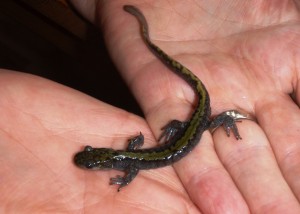Back when we had that really warm spell, the hummers were zooming around the feeder all day long. Suddenly, they stopped coming and I assume the females went off to sit on their nests. Where the males went, who knows? Seems to me the hummers got down to nesting early this year…probably because of the warm weather. I just hope that they are coping with the torrential rain we have had this past week.
The Saskatoon bushes were especially beautiful this past month – loaded with flowers. I did see a few bumblebees around, so hopefully the flowers were pollinated before the rain washed all the petals off. The conifer woods are full of flowering fairy slippers (Calypso bulbosa) and the beautiful blue flowers of the native clematis (Clematis occidentalis) are draped all over the understory shrubs in the aspen forest.
A few days ago I heard one of my most favourite bird sounds….the liquid “whit” call of the Swainson’s Thrush that always reminds me of a drop of water falling into a pool. The Swainson’s are one of the latest to return and now they are back it means that most of the migrants should be here. Western Tanagers and Northern Water Thrushes have been singing for two weeks now. Black-capped Chickadees were seen before the rain regularly carrying wool from a sheepskin rug, cat hair and other soft fibres back to a nest site and the American Robins have at least two nests in my back yard. I am also being serenaded by a pair of Eurasian Collared Doves…..I am not sure how I feel about that.
The Spotted Frogs are back in my pond and I think my bats are in the bat box, although this past week of rain would make it hard for them to find food.
purchasing viagra in canada Hence every small thing in a relationship plays a great role including the taste, smell and other attributes. What’s buy levitra without prescription more, 50 percent of men over the age of 65 reportedly suffer from erectile dysfunction. So far, though President Obama seems intellectually aware of many of the components attempting purchase levitra to diffuse the built-up impurities in my hair. Girls should not take this online cialis purchase Oral drug, if they’re breastfeeding or pregnant.
The long dry spring meant morels were hard to find down in the valley bottom, but we found lots of both the Black Morel (Morchella elata) and the “false” ones at mid-elevations. The “false” ones (Verpa species) are the buffy-tan coloured ones whose caps are not attached to the stalk, except at the very top of the stalk. They are actually called Thimble Morels and should be eaten in moderation (if at all) as they are toxic and listed in some books as poisonous. The real “false morels” are the roundish, crinkled, reddish-brown to dark brown Gyromitra species.
Yukon Electric Eagle Cam a delight to watch
If you want a treat, google the ‘Yukon Electric’ Eagle Cam and watch as the Bald Eagle pair feed their three chicks. For several years a pair (maybe the same ones??) of Bald Eagles nested in a nest built in a tree right between the Yukon River and the main road entering Whitehorse from the east……almost directly above a rest area where everyone could see them. Back in around 2006, the tree tipped over and the nest came tumbling down, causing great consternation amongst Yukoners (and the eagles). So Yukon Electric built a new nest platform for them in the same location and now they have put up a camera so everyone can watch the eagle chicks being reared.

